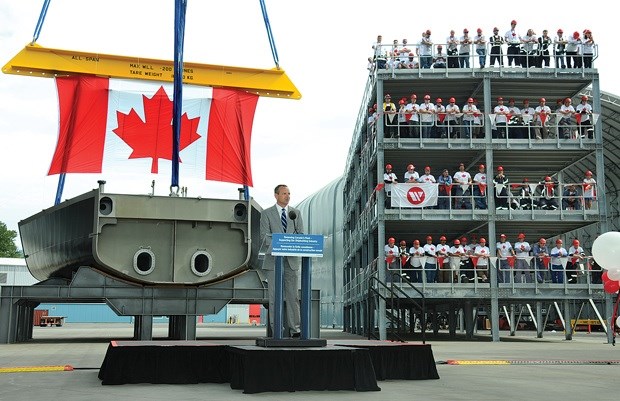Workers at North Vancouver’s Seaspan Shipyards are finally down to cutting steel for the first of the federal government’s non-combat vessels.
Construction officially began on the first of three fisheries science vessels this week, a milestone that was celebrated by both shipyard workers and federal politicians in North Vancouver Wednesday.
Seaspan recently signed a contract to build the first three ships for a maximum price of $514 million.
North Vancouver MP Andrew Saxton announced the first of those ships, to be finished in the spring of 2017, will be named Sir John Franklin, in honour of the Arctic explorer.
The wreck of one of Franklin’s ships, the Erebus, was found on the Arctic sea floor in September 2014.
The other two fisheries vessels are expected to be finished later in 2017.
The 55-metre vessels will be operated by the Canadian Coast Guard and used by fisheries scientists to do assessments of fish stocks and the marine ecosystem, as well as respond to marine emergencies.
On Wednesday, workers at Seaspan flanked the first “production block,” which will become part of the first fisheries vessel built at the shipyard. The first ship will be made up of 41 blocks.
Over the past two years, the North Vancouver shipyard has undergone a dramatic $155-million modernization project.
To build the ships under Ottawa’s national shipbuilding program, the shipyard will operate more like a manufacturing plant, building huge modular pieces on what is essentially an assembly line, then putting those together.
The workforce in the trades at the shipyard is expected to swell from about 200 currently to more than 500 workers over the course of the next year.
Diane Finley, minister of public works and government services, was in North Vancouver Wednesday to announce the start of construction on the non-combat shipbuilding program.
Finley noted Ottawa will continue to work with Seaspan as the ships are built “to ensure that Canadian taxpayers get the best value for their money.”
At $687 million, the total project budget for the three fisheries vessels is almost three times the original budget estimate for the project.
Officials have said the original $244 estimate, developed in 2004, didn’t contain provision for inflation, project management, engineering or design costs and didn’t include enough contingency.
Under approximately $11 billion in umbrella agreements between Ottawa and Seaspan, the North Vancouver shipyard is also slated to build one 78-metre offshore oceanographic science vessel, two massive 173-metre navy joint support ships, a polar icebreaker and up to 10 smaller Coast Guard vessels. That’s expected to provide about 15 years of work at the shipyard.
On Wednesday, Saxton said that’s a significant boost for the local economy in the Lower Mainland.
The federal government and Seaspan have yet to reach an agreement on contracts to build either the oceanographic science vessel or the two massive navy joint support ships.
In 2013, both the parliamentary budget officer and the auditor general raised questions about whether the $2.6 billion set aside by Ottawa will be enough to build the two joint support ships.
According to a report in the Ottawa Citizen this week, recent defence department documents have pointed to continuing concerns in Ottawa about possible construction delays and increased costs on the joint support ship project.
The federal government has recently indicated it will enter into talks with Davie Shipyard in Quebec about the possibility of retrofitting a commercial supply ship to provide a stopgap navy ship while the joint support ships are under construction at Seaspan.



